A chicken coop is not built in every country house. Chickens are unpretentious, but they need to be provided with food, drink, an open-air cage, and nests. You can make the task of caring for birds easier by building an automatic chicken coop.
What is a smart chicken coop
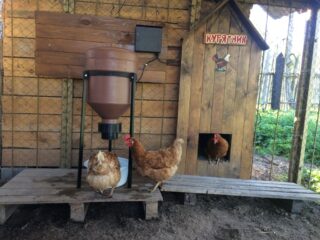
Even the simplest mechanization of some functions makes life easier for the owner of the chicken coop. Automatic drinkers allow you to change the water once a day, simply by filling the main tank. Turning off and on the lights eliminates the need to walk around the yard late at night and early in the morning in winter.
An autonomous chicken coop combines automation, remote control and independence from external conditions. This option can survive unattended for 2 weeks and provide the birds with warmth, drink, food and light.
The advantages of an autonomous system over a mechanical model are significant.
- Automatic heating - heating is adjusted to maintain a comfortable temperature for the bird. Heaters operate in an economical mode. The required difference in daily temperature is taken into account. In addition, the control panel allows you to set different heating in different areas. The chick compartment needs to be heated more intensively. The area with nests for laying hens does not need good heating.
- Short daylight hours affect egg production, so electric lighting is used in autumn and winter. Automation allows you to configure the turning on and off the lighting at the appointed time.
- The drinking system can be connected to a water supply system and a smart home. In this case, the supply of clean water becomes automated.
- It is possible to automate the preparation of feed and feeding it to the birds, as well as the removal of excess.
- You can also take control of ventilation, which is important in the hot season.
- The automatic egg collector prevents chickens from pecking eggs. And you can not pick them up every day.
- A smart automatic chicken coop for a private house provides bird protection. The house can be equipped with an alarm.
- Job data can be transferred to the owner's phone or laptop. At the same time, the owner of the cottage can control the system from a distance and change the settings.
The only drawback is the need for electricity.
The water supply, ventilation, heating system can be synchronized with the “smart home” system. To do this, you need to equip the chicken farm with special sensors. The most commonly used hardware and equipment of the Arduino complex. The poultry house is equipped with Wi-Fi and monitored with the help of gadgets coupled with the Smart Home software.
Comfortable microclimate in the chicken coop
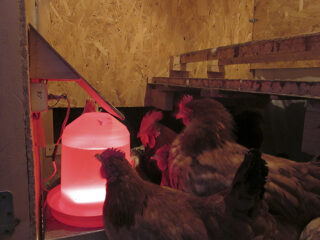
Set up the automated house system according to the recommended parameters.
- Temperatures from +5 to +23 C. At low temperatures, the bird spends too many calories on heat exchange and may stop rushing altogether. At high - above +30 C, eggs become small, and later oviposition also stops.
- Humidity - within 60-75%. If the humidity is too high or low, the birds get sick.
- Recommended air exchange is up to 7 m³ of air per hour per 1 kg of live weight.Chickens have a higher body temperature, so they generate heat more intensively when they breathe. Low air exchange leads to the accumulation of carbon dioxide, which is bad for bird health.
- Daylight hours should be 12 hours. At a shorter duration, egg-laying decreases or stops. You need to turn on and off the light at the same time.
Do not allow water to freeze in drinkers.
What is automation
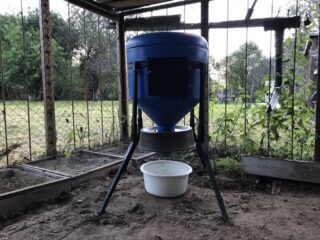
Any processes can be automated in the poultry house. This does not mean that an autonomous chicken coop in the country, built with your own hands, will not need supervision at all, but the latter can be reduced to a minimum.
Feeder management
Feeding birds is easy to automate, even without the need for software boards. The basis is the standard hopper feeders, which have long been used in large farms.
The feed is poured into a special container for up to 2 weeks - a barrel or a 20-liter bottle. A control device with a battery and a timer is connected to the hopper. The bunker and automatics are placed high enough so that the chickens cannot reach it. Food on a signal - better than a sound signal, so that the birds can easily remember it, is fed through pipes to the feeders.
Control options depend on the panel. Set the serving time and portion size. The system is recommended to be supplemented with cleaning - washing, mechanical cleaning of the feeders to prevent the accumulation of unused feed.
It is allowed to load only dry food into auto feeders.
Autodrinkers
Drinking bowls are organized according to the same principle. The container is set at a height, polyethylene pipes are connected and water is supplied to the drinking bowls. Most often, models with valves are used. The bird presses on the drinker and receives exactly the amount of water that it needs.
For chicks, use the shallow bowl option. In this case, there is always water in the drinking container and is renewed as the liquid is used.
Maintaining temperature
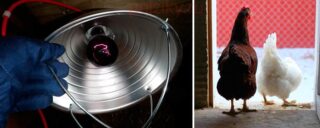
The best option for heating the chicken coop is infrared lamps. They are easy to install and designed for different heating areas.
Lamps are placed high enough so that the bird does not burn. They are connected to the general control circuit. On the panel, the house owner sets the temperature or heating time. In the first case, a temperature sensor is also required, which is connected to the Aurdino microcontroller. In this case, the temperature regime of the farm can be controlled remotely.
Ventilation
In the hen house, you need to maintain a fairly intense air exchange. Chickens breathe more carbon dioxide. The manure in the house saturates the air with ammonia vapor. Therefore, good air circulation is necessary here.
The model is simple: the supply ventilation pipe is mounted low above the floor, the exhaust pipe is mounted under the ceiling. The minimum distance between them is 1 m. However, if the house contains more than 20 individuals, it is better to equip the ventilation with a fan or even two.
Chickens are very sensitive to drafts, so the ventilation system must be carefully calculated.
Lighting
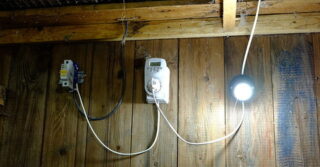
The simplest automation option is to connect a relay with a timer, which indicates the time the light is turned on and off. The only remark: the model must be moisture resistant, as the humidity in the house is fair.
Chickens wake up early. Therefore, the time for turning on the lighting is set in the region of 5-6 hours.
Features of automatic doors
An automatic door for a chicken coop - purchased or made by hand - allows chickens to freely go outside in warm weather. And in winter, it does not let out into the yard if it rains, snows or a severe frost has come.
This is achieved by installing a photosensor above the manhole, which reacts to the level of illumination on the street, and a thermostat. When the light switch detects the coming of the morning, the thermostat turns on and measures the temperature.If it is higher than the set value, the sash is not blocked and birds can escape. If lower, the door remains closed until the temperature reaches the desired value.
The door is set up so that it opens gradually, and in the evening the birds that have gone on a spree could get into the chicken coop.
The sash is made of lightweight plastic sheathing to avoid injury.
Humidity sensor
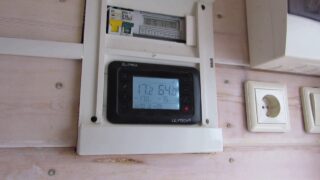
It is rare, since due to intense breathing, the humidity in the chicken coop remains high. The need for it appears when hatching chickens: in this area, the heating is much more intense. The humidity sensor is “tied” to the fan in the hood. When the air becomes too dry, the sensor gives a signal to reduce fan speed or shutdown.
Signaling
A smart chicken coop is often equipped with an alarm. In rural areas, and even more so in dachas, where the owners live fickle, theft of birds and eggs flourishes. However, the usual housekeeping techniques are not suitable.
The most popular option is a magnetic contact. The device is installed on the door jamb, and the receiver is placed in the house. An alarm is triggered when the doors are unauthorized.
Care and management of an automated chicken coop
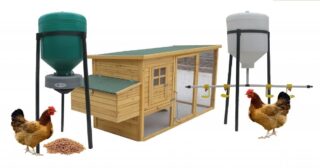
In order for an automated smart chicken coop to work smoothly, a number of simple rules are followed.
- Only dry feed can be placed in the hopper. At the same time, it is taken into account that the need for water in birds will increase.
- The water in the container deteriorates rather quickly. Therefore, leaving more than a two-week supply of fluid is not allowed. Before pouring a new portion, wash the container.
- Waste - droppings, chicken bedding, uneaten food, can be partially stored near the chicken coop. However, it is a source of ammonia evaporation. Waste should be removed as often as possible and used for fertilization.
- Errors and malfunctions in the electronic part of the system are reported by the control panel. These signals cannot be ignored.
- It is only necessary to lay wires in the hen house in an insulating sheath.
- From time to time it is necessary to clean, wash and disinfect feeders, drinkers, egg collectors, and other parts of the system.
An automated chicken coop makes bird care easier. The control system allows you to adjust the light mode, maintain a comfortable temperature and humidity, and even monitor the integrity of the eggs.








